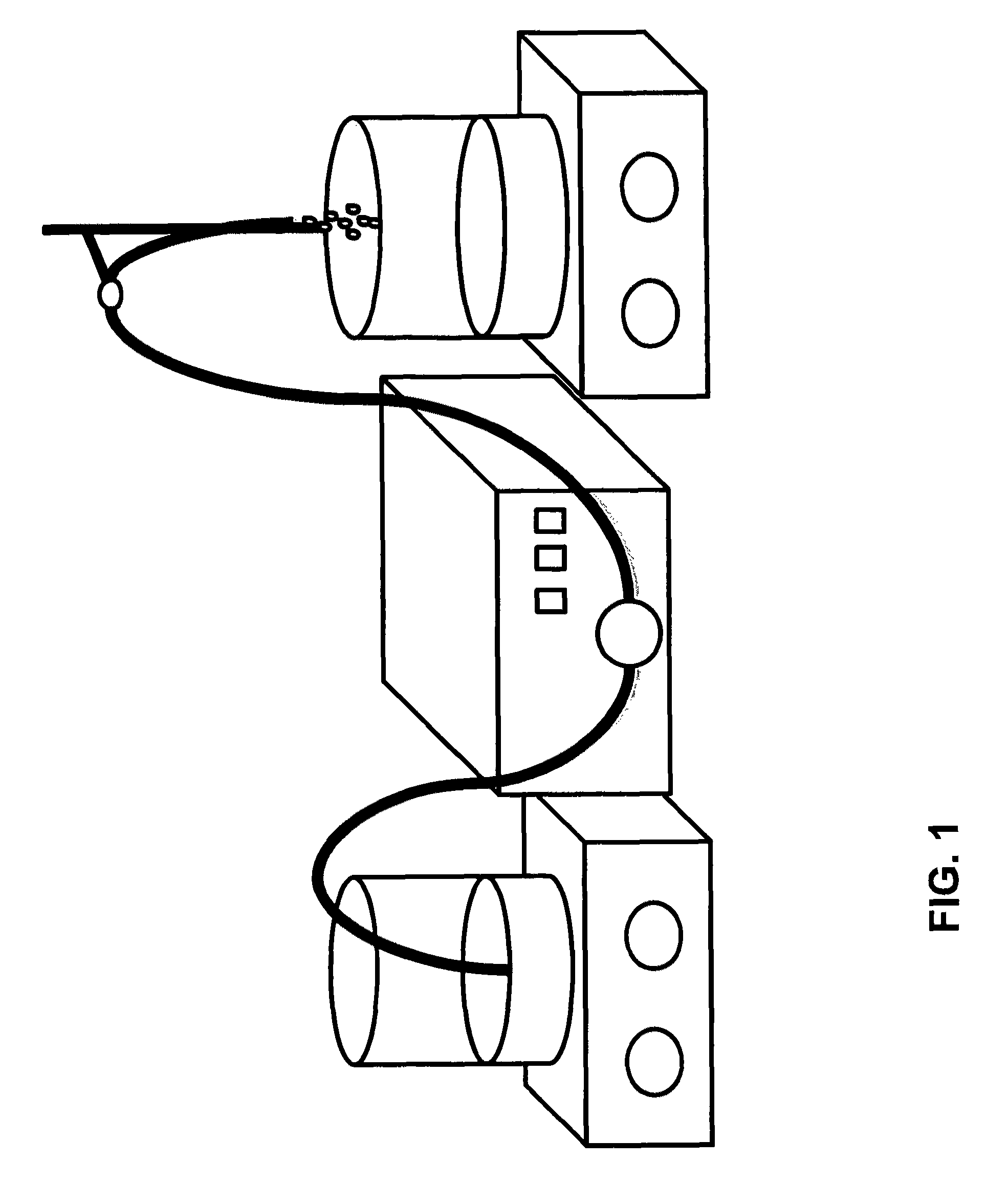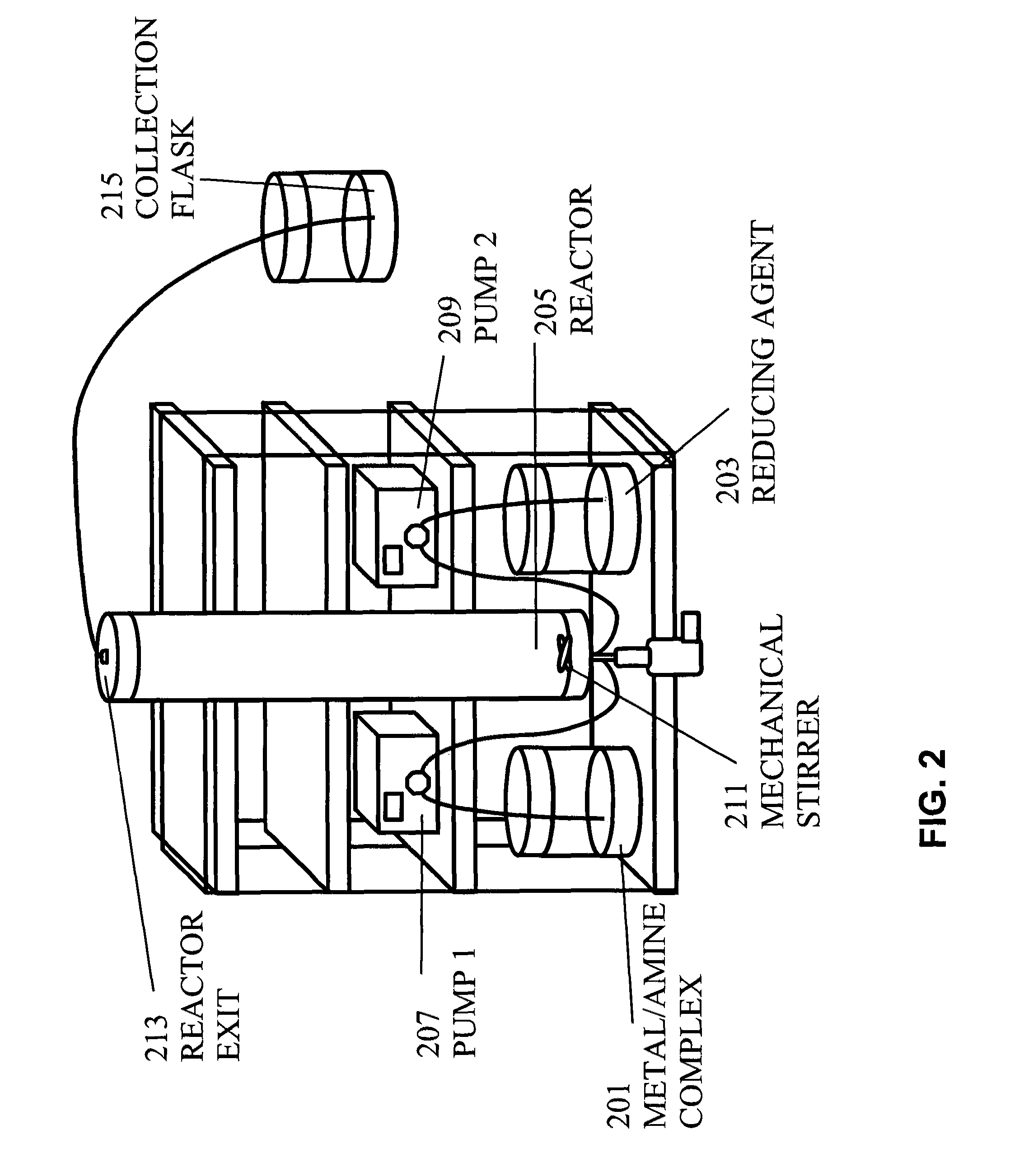Method of controlled synthesis of nanoparticles
a nanoparticle and controlled synthesis technology, applied in nanotechnology, nanotechnology, etc., can solve the problems of not being well controlled, reducing the material used in the printed circuit by approximately 10 times, and lowering production costs, so as to achieve low cost, high quality, and simple procedures
- Summary
- Abstract
- Description
- Claims
- Application Information
AI Technical Summary
Benefits of technology
Problems solved by technology
Method used
Image
Examples
example 1
Synthesis of Silver Nanoparticles
[0046]Synthesis of Silver Nanoparticles from Ethanol Solution.
[0047]10 g of silver nitrate (AgNO3) was dissolved in a reaction medium consisting of 60 ml of 200 proof ethanol and 83 ml of oleylamine under vigorous stirring to create the metal / amine complex. Separately, 0.8 g of sodium borohydride (NaBH4) was dissolved in 200 ml of 200 proof ethanol to create the reducing agent. The sodium borohydride reducing agent was slowly pumped at different flow rates (from 2 ml / min to 10 ml / min) into the metal / amine complex under vigorous stirring. FIG. 1 illustrates the apparatus used in the synthesis in the batch process.
[0048]When the flow rate of sodium borohydride of 5 ml / min was used, the reaction was typically stopped after thirty-five minutes. The reaction was controlled by UV / V is absorbance by measuring spectra every three to five minutes. The peak intensity of silver increased with time. Typically the peak became narrower after ten to twenty-five min...
example 2
Synthesis of Gold Nanoparticles from Toluene Solution
[0055]The synthesis of gold nanoparticles was performed under conditions similar to the previously described nanoparticles. 15.6 g of gold trichloride or tetrachlorohydroauric acid was dissolved in 80 ml of oleylamine and 290 ml of toluene under vigorous stirring to create the metal / amine complex. Separately 2.2 g of NaBH4 was dissolved in 500 ml of 200 proof ethanol to create the reducing agent. The reducing agent was pumped at 5 ml / min into the metal / amine complex. Total reaction time was 56 min. The process was controlled by UV / V is absorbance. After the synthesis, methanol was added to allow gold nanoparticles precipitate. Particles were isolated and purified by centrifugation similar to silver nanoparticles. Absorbance and TEM of gold nanoparticles are shown in FIG. 4.
[0056]The synthesis of gold nanoparticles was also conducted utilizing the continuous flow method as described above.
example 3
Synthesis of Platinum Nanoparticles from Ethanol Solution
[0057]The synthesis of gold nanoparticles was performed under conditions similar to the previously described nanoparticles. 0.5 g of PtCl2 was dissolved in 6.2 mL of oleylamine and 83 mL of 200 proof ethanol to create the metal / amine complex. The metal / amine complex was stirred at room temperature for approximately one hour until the Pt salt dissolves. In a separate flask 0.9 g of Sodium Borohydride was dissolved in 200 mL of 200 proof ethanol to create the reducing agent.
[0058]The metal / amine complex was titrated with the reducing agent at 5 ml / min flow rate. The titration was stopped after twenty minutes. The resulting solution was centrifuged and then redissolved in appropriate solvent, typically hexane or toluene.
[0059]This reaction produced platinum nanoparticles approximately 5 to 10 nm in size. TEM and powder diffraction of platinum nanoparticles are shown in FIG. 6.
[0060]Toluene was also used as a solvent in the reacti...
PUM
| Property | Measurement | Unit |
|---|---|---|
| size | aaaaa | aaaaa |
| size | aaaaa | aaaaa |
| size | aaaaa | aaaaa |
Abstract
Description
Claims
Application Information
 Login to View More
Login to View More - R&D
- Intellectual Property
- Life Sciences
- Materials
- Tech Scout
- Unparalleled Data Quality
- Higher Quality Content
- 60% Fewer Hallucinations
Browse by: Latest US Patents, China's latest patents, Technical Efficacy Thesaurus, Application Domain, Technology Topic, Popular Technical Reports.
© 2025 PatSnap. All rights reserved.Legal|Privacy policy|Modern Slavery Act Transparency Statement|Sitemap|About US| Contact US: help@patsnap.com



